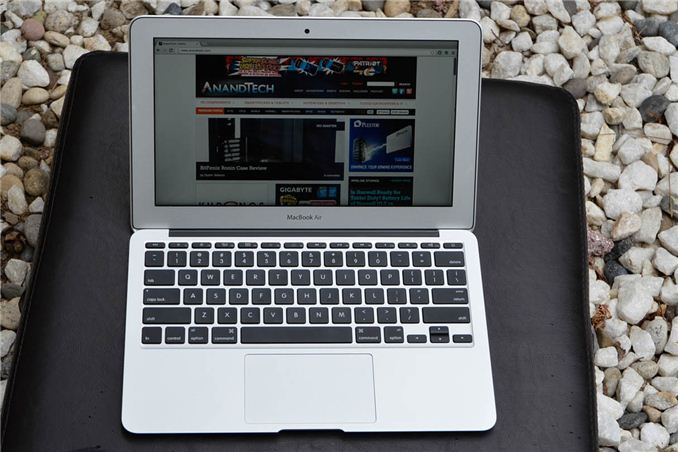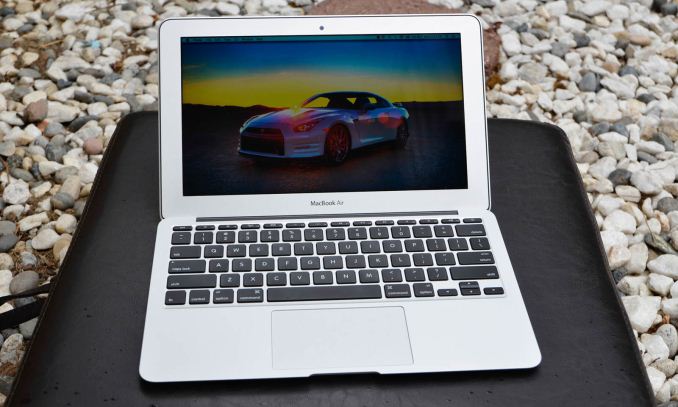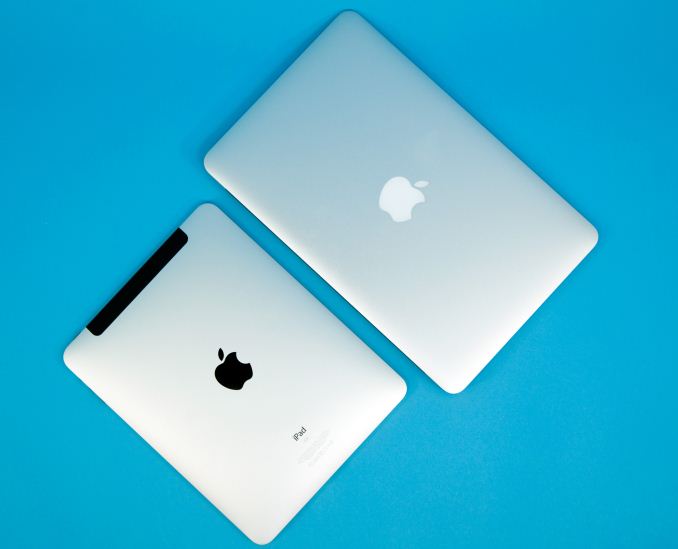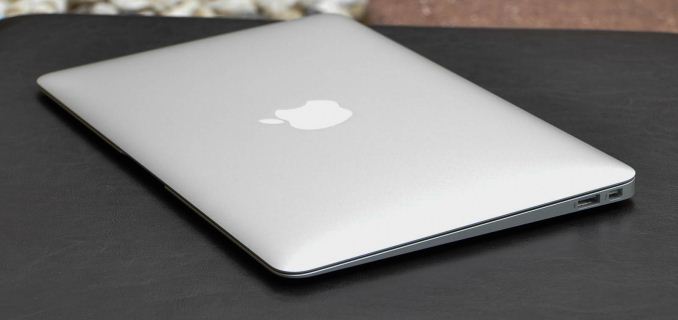The 2013 MacBook Air Review (11-inch)
by Vivek Gowri on August 9, 2013 1:45 AM EST
When Apple launched the second generation MacBook Air in late 2010, I was definitely more interested in the 11” model. It was nearly as small as the iPad, but as a full notebook it was considerably more useful. At 2.3lbs, it wasn’t even that much heavier and the $999 pricetag made it the least expensive mobile computer in Apple’s lineup. It wasn’t really perfect: the base SKU with a 1.4GHz Core 2 Duo ULV CPU and 2GB of memory seemed painfully inadequate at the time, the 5 hour battery life wasn’t great (the 13” Air was rated at a much better 7 hours), and $999, though cheap by Apple notebook standards, was a lot to justify spending on roughly year-old specs. Needless to say, I bought one. (Jarred’s thoughts at the time: “It has an Apple logo on it, so of course you bought one!”) And then I returned it. It was just unbearably slow
The base 2011 model having only 2GB RAM was basically laughable, and the standard 64GB SSD got a whole lot more indefensible as time went on, but the experience was significantly improved by the switch to modern microarchitectures in the newer 11” Airs. But even so, the 13”, with its higher screen resolution, 16:10 aspect ratio, and larger battery, seemed to be the way to go, especially after the price dropped to $1199.
For 2013, the entry level 11” and 13” SKUs have the same basic specs: 1.3GHz Haswell ULT processor, 4GB LPDDR3, and a 128GB SSD. The price difference has dropped to $100, with the 13” falling to $1099—making it feel like a way better deal, considering the extra battery life (12 hours versus 9 for the 11”) and larger, higher resolution display. And honestly, the 13” is not only a more usable primary computing solution, but also a better computer overall, so I’ll just get that part out of the way first. I will say though, it’s far easier to recommend an Air 11” now that the base model has the 4GB/128GB combo I’d consider the minimum for any ultraportable computer. It took a few years, but it finally became possible to recommend the base 11”er without any caveats. Where the 11” Air becomes really interesting though is when you stop thinking about it in terms of its larger sibling, but in terms of the iPad.
| 2013 MacBook Air Lineup | ||||||
| 11.6-inch | 11.6-inch (high-end) | 13.3-inch | 13.3-inch (high-end) | |||
| Dimensions |
H: 0.11-0.68" (0.3-1.7cm)
W: 11.8" (30cm) D: 7.56" (19.2cm) |
H: 0.11-0.68" (0.3-1.7cm)
W: 12.8" (32.5cm) D: 8.94" (22.7cm) |
||||
| Weight | 2.38 lbs (1.08kg) | 2.96 lbs (1.35kg) | ||||
| CPU | 1.3GHz dual-core Core i5-4250U | |||||
| GPU | Intel HD 5000 | |||||
| RAM | 4GB LPDDR3-1600 | |||||
| SSD | 128GB PCIe SSD | 256GB PCIe SSD | 128GB PCIe SSD | 256GB PCIe SSD | ||
| Display Resolution | 1366 x 768 | 1440 x 900 | ||||
| Ports | Thunderbolt, 2x USB 3.0, headphone jack | Thunderbolt, 2x USB 3.0, SD card slot, headphone jack | ||||
| Networking | 2x2:2 802.11ac | |||||
| Battery | 38 Wh | 54 Wh | ||||
| Price | $999 | $1199 | $1099 | $1299 | ||
Not only is the Air 11” dimensionally similar to the iPad, but now with Haswell it has roughly equal battery life too. And given that there’s just a $200 price difference between the 128GB iPad and the 128GB Air 11”—$100 if you factor in the cost of an iPad keyboard—it’s really something to think about. Sure, the iPad has a better display and is touch capable, but this is a real computer. It’s just as easy for me to carry the Air 11” as it is for me to carry the iPad, it even fits into the iPad pocket in my backpack.
The images Anand took for the first 2010 Air review keep coming back to me—the size difference really isn’t that much. The current iPad is thinner and lighter than the first gen that we had back then, but not by much, and the footprint hasn’t changed at all. Other than the extra 2.3” in width and few hundred grams in weight (it’s just under a pound heavier), the two are pretty similar. The depths are within a quarter inch of each other and the average thickness of the wedge-shaped Air is essentially the same as the constant thickness of the iPad. So this form factor with this battery life and these specs—does that make the 11” Air compelling enough to justify buying instead of the 13” or another PC notebook in this class?
Hardware
We’re really familiar with this generation of MacBook Air. This is now the fourth generation using this chassis (C2D, SNB, IVB, now Haswell) and in that time, not much has changed. The Air family added Thunderbolt and backlit keyboards in 2011 and moved to MagSafe 2, USB 3.0, and HD webcams last year, but other than that, this is externally essentially the same computer it was back in 2010. This year, the Air gets a second microphone hole in the left side. For reasons unknown, the listed weight for the Air 11” changed from 2.3lbs to 2.38lbs between 2010 and 2011, but has stayed constant at the latter in the generations since.
The chassis is still phenomenally thin and very well put together, with a pleasing simplicity and extremely compact dimensions all around. The keyboard and trackpad are still the best on the market, and it’s awesome to note the uniformity of Apple’s keyboard from the 11” Air through the rest of their larger notebooks and the wireless keyboard that ships with the iMac. I don’t understand how nobody else has figured out how to make a buttonless trackpad as good as Apple’s at any point over the last five years. Over the last few years, I’ve been tempted to buy a Mac more than a few times just because of how good the input devices are. It’s legitimately an advantage that Apple holds for their entire notebook lineup, one that is very critical in a smaller notebook like this one. There’s not much in the way of port selection, but that’s actually not too big of a deal. Perhaps after years of living with ultramobile systems, I’ve learned to make do with just two USB ports and a video out, but it’s honestly good enough for this class of notebook.
There’s a lot new on the inside though. In addition to Haswell ULT, Apple has pushed the envelope and gone for PCIe SSDs and 802.11ac. Considering the other innovations Apple has brought to the mobile computing space over the years, it’s probably not that surprising that they were the first to get ac and PCIe storage into Ultrabooks. Sony has since also started shipping a set of similar systems with PCIe SSDs in their VAIO Pro Ultrabook line, and I’d be very surprised if many of the other high-end Ultrabooks set to launch later in the year don’t have at least one of those two things.
Anand has covered the different Haswell ULT parts used in the Airs pretty in-depth so I’m not going to go into too much detail here. The base model Air 11” that we’re looking at today has the i5-4250U, a 1.3GHz part with max turbos of 2.6/2.3GHz (1C/2C) and Intel’s HD 5000 onboard graphics with a max GPU clock of 1GHz. The i7-4650U is a $150 option and bumps base clock to 1.7GHz, turbo to 3.3/2.9GHz (1C/2C), and GPU max to 1.1GHz. I typically don’t go in for Apple’s upgrade pricing, but this is actually pretty reasonable given the performance increases involved. I think I’d be more tempted to go for the upgraded CPU in a 13”, simply because I’d want to eke every drop of battery I could get from the smaller notebook. The battery has been upsized, now to 38Wh from the previous 35. It’s still a fair ways behind the 13” in terms of battery capacity though; the 54Wh battery in the larger unit represents a 42% increase in size that more than offsets the display-related power consumption delta.



















139 Comments
View All Comments
teiglin - Friday, August 9, 2013 - link
Minor correction: I believe the Vaio Pro 11 has a 31Wh battery (spec page says 4125mAh, pretty sure it's 7.5V).I hadn't realized the Vaio Pro had come down already--and the Sony website is having a most upgrades discounted--only $120 to go from 128->256GB SSD is especially appealing. If you include the rebate, an 8GB/256GB Vaio Pro 11 is only $1250 compared to $1300 for the same configuration of 11" Air. There is certainly an argument to be made in favor of the Air's body over the flexible carbon fiber Vaio Pro, and the Air certainly has the advantage in battery, touchpad, and GT3; in my opinion, though, a 768p TN panel has no place in a $1000+ device any more.
ananduser - Friday, August 9, 2013 - link
GT3 is not all that it could have been since it's hampered by the 15W TDP of the SKU. HD4400 has proven faster in certain areas when paired with a faster CPU than what the MBA sports. I believe Anand showed this in the original MBA13" review.Glindon - Friday, August 9, 2013 - link
If I recall correctly the CPU turbo boost is the same on 4600 and 5000 models. So unless you are using the graphics at full bore the CPUs should be comparable. I'd rather have better graphics.ananduser - Saturday, August 10, 2013 - link
At low frequencies a 300MHz-500MHz increase is noticeable. Again I point to Anand's review of the faster 13" MBA. Thus the CPUs are not comparable and it is this that allows the the HD5000 to underperform in certain areas compared to HD4400.iwod - Friday, August 9, 2013 - link
I would love to get a bigger screen with the Current 11" MBA. Which is still leaving quite lot of bezel space left and right. The Size of 11" MBA is perfect. But Just that slightly larger display would do. The same goes for 13" where it could actually fit in a 13.9" or 14" LCD instead.Other then that, Anand has already covered there are lot of space left in the MBA circuits which means next generation Broadwell CPU will get that redesign along with even bigger battery. Along with better software and Video Decode. So i think the MBA this year is good. The next one is going to be Great.
DesktopMan - Saturday, August 10, 2013 - link
Totally agree about the bezel. Could probably fit a 12 inch display there.EnzoFX - Saturday, August 10, 2013 - link
Of course it can. Since the current display is 11.6". =p
Daniel Egger - Friday, August 9, 2013 - link
Why would Apple want to radically change a proven chassis design? Just because it looks aged? Sorry but that is bollocks. I would even go so far as to say this is by far the best design in the market and as long as no one (including Apple) can come up with a better package they should stay with this one and make incremental changes, like getting rid of the f...ing bezel around the screen and have a matte gorilla glass screen going edge to edge.GekkePrutser - Friday, August 9, 2013 - link
In my opinion it's not that it looks aged, the only thing that looks out of place is the large bezel (especially on the 11")But the problem is that it no longer pushes the envelope. When Apple released the 2010 model it was the smallest and lightest you could buy for the price (not including much lower-specced netbooks).
Now everyone is doing unibodies and they're all at the same point, most of them are doing it better than Apple (e.g. Samsung with their small bezels and better screens). I think Apple should keep pushing forward, and push the 'ultramobile' thing to the max again. I'd love to see something similar to this: http://www.engadget.com/2013/04/19/inhon-blade-13-... a 870g/1.9lbs 13" laptop..
nerd1 - Friday, August 9, 2013 - link
Huge bezel, terrible resolution (and TN screen), heavier than others (compared to series 9 / vaio pro etc which are almost 25% lighter)